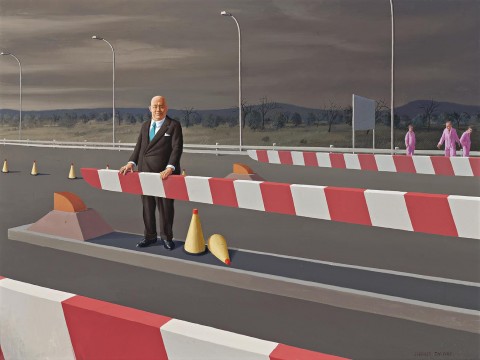ENTRANCE TO THE AUTOSTRADA, 1966 – 67
JEFFREY SMART
oil on canvas
60.5 x 80.5 cm
signed lower right: JEFFREY SMART
inscribed with title verso: Entrance to the Autostrada
inscribed on stretcher bar verso: THE MODEL FOR THE FIGURE (NOT THE FACE) WAS ALAN McELWAIN !
South Yarra Gallery, Melbourne
Alan and Nola Geddes, Sydney
Estate of Nola Geddes, Sydney
Jeffrey Smart, Redfern Gallery, London, 7 February – 4 March 1967, cat. 17
Jeffrey Smart Recent Paintings, Macquarie Galleries, Sydney, 31 May – 12 June 1967, cat. 12
Jeffrey Smart, South Yarra Gallery, Melbourne, 21 May 1968, cat. 17
Quartermaine, P., Jeffrey Smart, Gryphon Books, Melbourne, 1983, cat. 507, p. 110 (incorrect date and size)
We are grateful to Stephen Rogers, Archivist for the Estate of Jeffrey Smart, for his assistance in cataloguing this work.
The Autostrada and its signage fascinated Jeffrey Smart. From Entrance to the Autostrada, 1966 – 67 and its bookend, End of the Autostrada, 1968 – 69 (private collection) through The Directors, 1977 (Art Gallery of Western Australia, Perth) to Autobahn in the Black Forest II, 1979 – 80 (sold Deutscher and Hackett, 20 April 2011), they are major highlights throughout his oeuvre. Smart wrote: ‘Italy was even more scenic from the autostrada – no hoardings were permitted; the only signs were those needed for the traffic and I found them beautiful, they were so well designed’.1 Smart’s interest in roads and their ways began early with the Australian version The Cahill Expressway, 1962 (National Gallery of Victoria, Melbourne) being among the best. The suited, bald-headed figures in Expressway and Entrance to the Autostrada share a similarity of purpose and stoutness, the model ‘(not the face)’ in this painting identified by Smart as Alan McElwain.2 In response to being questioned about his use of the human figure in painting, Smart wrote: ‘Very often the vertical black rectangle is a great help to me in a composition – it gives scale and the dark note sets a tone … A bald head makes a lonely volume and gives me a highlight’.3 In Entrance to the Autostrada it provides a balancing vertical accent, carried as a refrain through the brightly coloured overalls of the workers and elegantly drawn light poles. As if to curb the temptation of the suited man becoming a focal point, a red and white painted barrier cuts across the figure as a strong horizontal emphasis, repeated dramatically across the very foreground and further away. A favourite motif, it finds a high point in Autobahn in the Black Forest II, a veritable symphony in red and white stripes of now vertical directional signs. Both pictures are devoid of vehicles and movement.
The appeal of road apparatus is heightened by colour and light, contrasted against the drabness of the background landscape of shrouded greys. The play of light and absence of shade is surreal. Even the narrow edge of the road sign is highlighted, its message hidden from view. The enigma of the whole seems symbolised by the two yellow road cones, one upright the other on its side – of no other purpose? Of the 1967 exhibition in Sydney at the Macquarie Galleries, in which this painting was included, Wallace Thornton, art critic for The Sydney Morning Herald, wrote: ‘It is his way of achieving the starkness of buildings isolated in space – the sharpness of stripes and street signs – and the bite of forced tones or jumping colour associations that create his power to impress’.4 In his 2005 scholarly study, Barry Pearce tells us of Smart’s awakening ‘to the phenomenon of this new signage’. The construction of a new autostrada between Rome and Florence gave Smart the opportunity to be driven along it a few days before it opened; ‘The privilege of this was not only to be able to travel at 180 kilometres per hour with no-one else in sight, but also see all the newly designed directional markings untrammelled by the clutter of advertisements’.5 In Entrance to the Autostrada all looks new, sharpened by being seen through the eyes of a gifted artist.
1. Smart, J., Not Quite Straight: A Memoir, William Heinemann, Melbourne, 1996, p. 386
2. Peter Quartermaine identified the New Zealander, Alan McElwain, as ‘the Catholic Herald’s (UK) Rome correspondent at the time the work was painted’. Previously, he had worked in Sydney, Melbourne and Adelaide. Information kindly supplied by Stephen Rogers.
3. Quartermaine, P., Jeffrey Smart, Gryphon Books, Melbourne, 1983, p. 57
4. Thornton, W., Sydney Morning Herald, Sydney, 31 May 1967, p. 14
5. Pearce, B., Jeffrey Smart, The Beagle Press, Sydney, 2005, p. 157
DAVID THOMAS
